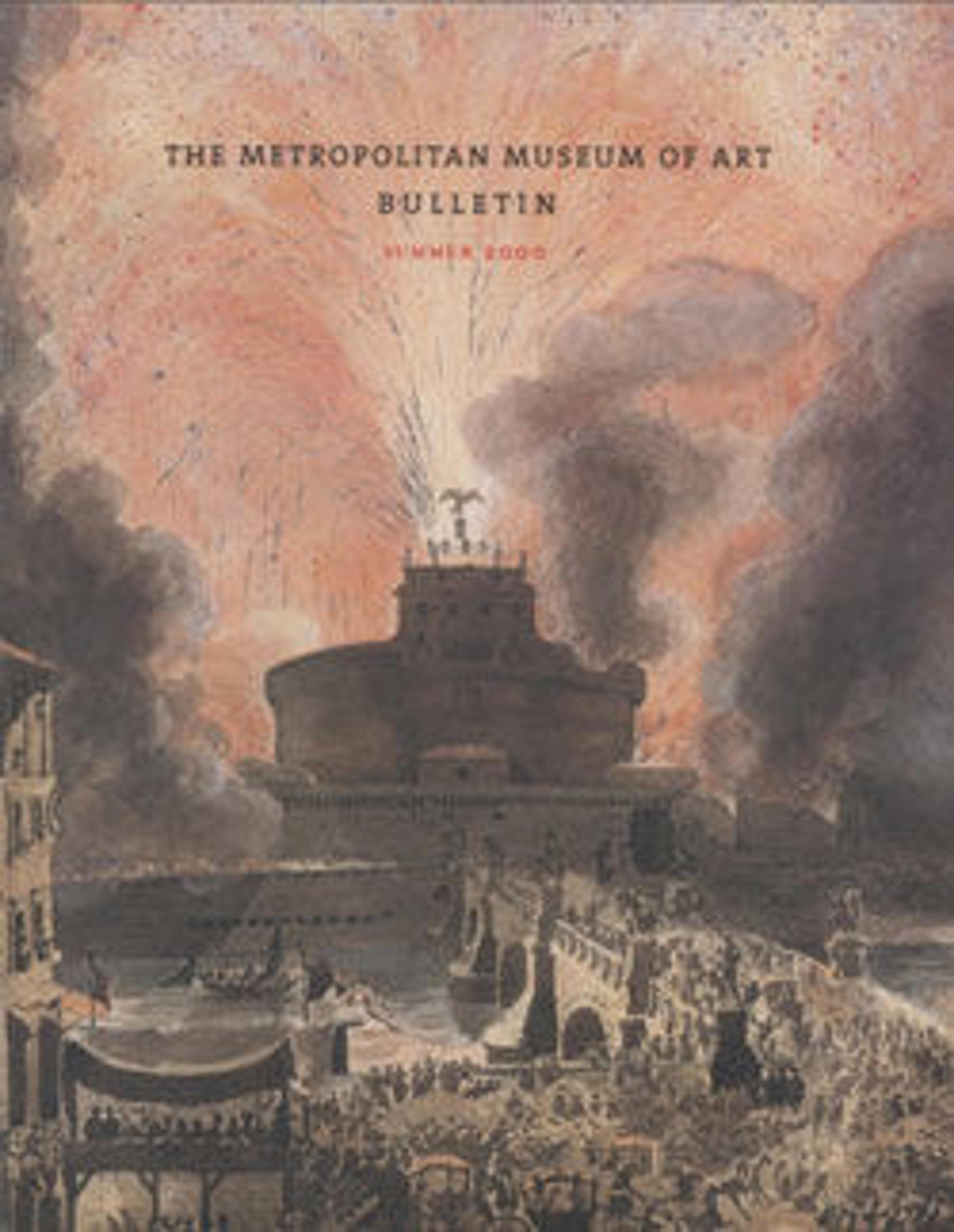Fireworks in a Piazza
Mahon (1968, no. 191, p.187) tentatively dated the Museum's drawing to the first phase of Guercino’s career, prior to his Roman sojourn of 1621-23. Mahon noted a similarity between the genre subject matter of the drawing and that of scenes painted by Guercino and assistants in the Casa Pannini, Cento (1617). Mahon suggests the possibility of the architecture reflecting the travels of Guercino's Venetian sojourn of 1618. William Griswold (1991) followed Mahon's dating to the pre-Roman period, noting similar realistic-looking, but fictitious architecture in the background of paintings such as the Manning Collection Tobias and the Angel (c. 1617). Supporting the dating in the pre-Roman period is also the related drawing of a piazza bonfire showing a similar conical straw construction attributed to the Circle of Guercino (Chatsworth, Devonshire Collection, inv. no. 548: see Jaffe 1994, cat. no. 568).
The subject matter is no less elusive. Because Guercino spent much of his life in Bologna, it has been suggested that these fireworks may have had a connection with the election to the papacy of the Bolognese Alessandro Ludovisi (Gregory XV, 1554-1523) in 1621. Although the piazza, with its distinctly Palladian palace to the left and its medieval tower from which fireworks are being shot off, is probably imaginary, the scene has a sense of reality and immediacy (Cazort and Johnston, 1982, no. 51, p. 92) .
In regards to the location of the piazza featured in the Museum's drawing, Denis Mahon (1968) commented that the architecture is too monumental to be that of the main piazza at Cento and that it also does not represent the Piazza Maggiore at Bologna. Of great interest, Janos Scholz stated in 1945 that the piazza shown in this drawing is the Piazza delle Erbe at Verona (note in departmental file: J. Bean, December 65 LN). Indeed this drawing portrays the Piazza delle Erbe, though not exactly in its current appearance. The palace in the drawing to the left of the bonfire, with its balustrade surmounted by freestanding figural sculptures, resembles the Palazzo Maffei in Verona's Piazza delle Erbe. Another structure from this piazza reflected in the Museum's drawing is the three-storey High Renaissance facade adjacent at a right angle to the Palladian facade. As is documented, Guercino went to Venice in 1618 and to Mantua in 1620. Verona is near to both cities. A structure similar to the Palazzo Maffei is Palladio's Palazzo Chiericati in Vicenza, which, like the palazzo of the Museum's drawing, has rectangular ground-floor bays open to the street and freestanding figural statues along the top of the facade. However, the exact arrangement of buildings in the Museum's drawing are yet unidentified and the drawing is very likely a pastiche of Emilian and Lombard piazze, which offer a similar combination of crenellated gothic rooflines and classicizing Renaissance facades.
The subject matter is no less elusive. Because Guercino spent much of his life in Bologna, it has been suggested that these fireworks may have had a connection with the election to the papacy of the Bolognese Alessandro Ludovisi (Gregory XV, 1554-1523) in 1621. Although the piazza, with its distinctly Palladian palace to the left and its medieval tower from which fireworks are being shot off, is probably imaginary, the scene has a sense of reality and immediacy (Cazort and Johnston, 1982, no. 51, p. 92) .
In regards to the location of the piazza featured in the Museum's drawing, Denis Mahon (1968) commented that the architecture is too monumental to be that of the main piazza at Cento and that it also does not represent the Piazza Maggiore at Bologna. Of great interest, Janos Scholz stated in 1945 that the piazza shown in this drawing is the Piazza delle Erbe at Verona (note in departmental file: J. Bean, December 65 LN). Indeed this drawing portrays the Piazza delle Erbe, though not exactly in its current appearance. The palace in the drawing to the left of the bonfire, with its balustrade surmounted by freestanding figural sculptures, resembles the Palazzo Maffei in Verona's Piazza delle Erbe. Another structure from this piazza reflected in the Museum's drawing is the three-storey High Renaissance facade adjacent at a right angle to the Palladian facade. As is documented, Guercino went to Venice in 1618 and to Mantua in 1620. Verona is near to both cities. A structure similar to the Palazzo Maffei is Palladio's Palazzo Chiericati in Vicenza, which, like the palazzo of the Museum's drawing, has rectangular ground-floor bays open to the street and freestanding figural statues along the top of the facade. However, the exact arrangement of buildings in the Museum's drawing are yet unidentified and the drawing is very likely a pastiche of Emilian and Lombard piazze, which offer a similar combination of crenellated gothic rooflines and classicizing Renaissance facades.
Artwork Details
- Title:Fireworks in a Piazza
- Artist:Guercino (Giovanni Francesco Barbieri) (Italian, Cento 1591–1666 Bologna)
- Date:ca. 1618–23
- Medium:Pen and brown ink, brush with gray and brown wash, over traces of leadpoint (?)
- Dimensions:sheet: 7 5/16 x 10 3/8 in. (18.6 x 26.4 cm)
- Classification:Drawings
- Credit Line:Rogers Fund, 1912
- Object Number:12.56.12
- Curatorial Department: Drawings and Prints
More Artwork
Research Resources
The Met provides unparalleled resources for research and welcomes an international community of students and scholars. The Met's Open Access API is where creators and researchers can connect to the The Met collection. Open Access data and public domain images are available for unrestricted commercial and noncommercial use without permission or fee.
To request images under copyright and other restrictions, please use this Image Request form.
Feedback
We continue to research and examine historical and cultural context for objects in The Met collection. If you have comments or questions about this object record, please contact us using the form below. The Museum looks forward to receiving your comments.
